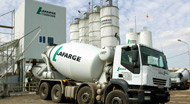Manufacturing process
Water plus cement plus aggregates. The formula seems simple, but the reality of concrete manufacturing is far more complex. The development of formulas for concrete requires very advanced scientific skills. The quality of the cement and aggregates, the dosage and the proportions are just some of the variables that influence the properties of concrete.
A simple recipe with many variables |
|
|
Concrete is a carefully balanced mix of cement, aggregates and water. Cement acts as the binder and modifies the characteristics and uses of concrete:
Aggregates, another essential ingredient in concrete, retain the intrinsic properties of the rocks that they come from. The color and chemical and physical characteristics of aggregates have a direct impact on the durability, esthetics and mechanical properties of concrete. |

Concrete productionThe ingredients used to manufacture concrete Concrete is a building material made by mixing aggregates and sand with a binding agent (usually cement) and, if necessary, with additives.The performance and characteristics of a concrete can vary greatly depending on the formula, the way it is used, etc. SuperplasticizerA superplasticizer is an additive that is mixed with concrete, mortar or grout just before the concrete is used. Its main purpose is to improve the workability of the mix. Its secondary role is to modify the setting or hardening time. Superplasticizers are sometimes called "fluidifiers". |
Additives for customized concrete |
|
|
Additives can be incorporated in small amounts (less than 10 kg/m³) to give concrete specific characteristics:
|
|





